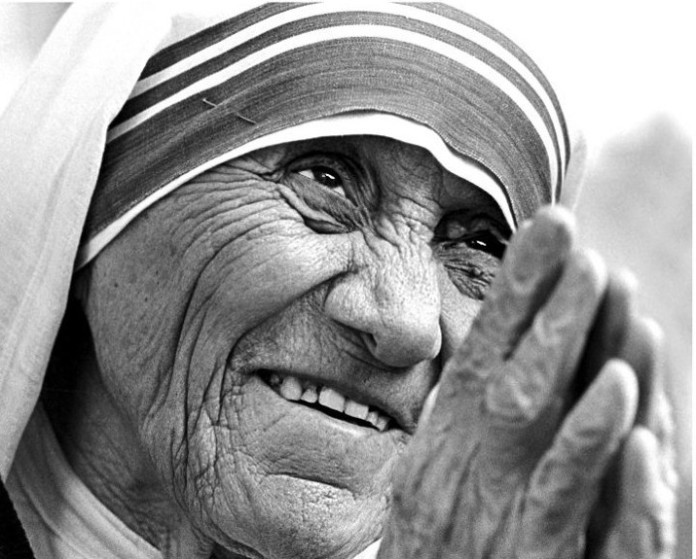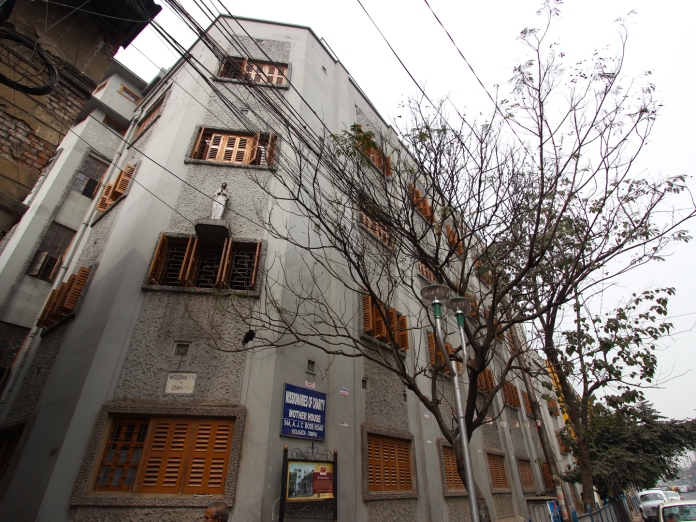I remember the autumn of 1997 when Princess Diana and Mother Teresa passed away within a span of five days. The world poured over condolences for the royal princess and obituaries were boundless. Princess Diana was still on the headlines when on the 5th of September, Mother Teresa took her last breath. Needless to say that her demise made worldwide news as well, but the loss of the octogenarian was not as widely mourned as was the people’s princess, who rebelled against the Royal family, her face with the famine-stricken African children melted the heart of millions and made her an ambassador for humanity. I too was one of the admirers saddened by her untimely departure, but looking back in time, I just think what a petty soppy crush it was, that loss of a Royal heiress — on her all paid philanthropy missions when she wasn’t too busy spending taxpayer money shopping — overshadowed a life sacrificed to helping the lives of millions of sufferers in a far-flung land, not by photoshoots but by living amongst the people she wanted to help. Princess Diana was a cover page celebrity, whilst Mother Teresa was an epitome of sacrifice, care and humanity. However, last month, when Pope Francis declared that Blessed Teresa of Calcutta will become a saint, I could not but smirk at the hypocrisy and connivance of Vatican even on the 21st Century over the recognition of miracles and conferring sainthood.

Source: TheInd.com
As I grew up in Calcutta, Mother Teresa was an inseparable part of the city’s identity. Mother House on AJC Bose road, which is the headquarters for her Missionaries of Charity institution, stood tall in a part of Calcutta known for its multicultural spirit. When she won the Nobel peace prize, it added another jewel on Calcutta’s claim to the Nobel connections. The Missionaries of Charity nurses in their white outfits with blue borders would become a regular feature in the slums and other backward areas. With time, Mother Teresa started to appear gaunter and her face looked to have developed more creases than before, yet she continued spreading the worlds of love and peace in Calcutta and to the outside world.
It is amazing how young Anjeze in present-day Macedonia came to know about the miseries of the people in Bengal and decided to move to Calcutta to care for the sufferers — and during that time, there weren’t many of them helping the poor. Palliative care was almost non-existent and leprosy was a social stigma, and the sufferers were ostracised, and therefore died of maltreatment of a condition that perhaps could have been cured. From the early 1950s, when she started MoC with only a handful of volunteers, until her death when it had become a large organisation operating in countries outside India — the transformation Mother Teresa brought about to millions of lives can only be termed as a miracle.
Miracle is an interesting word. On one hand, it represents an act out of the ordinary, but taking the meaning further, it could also be connoted as phenomena beyond human capabilities. For years Mother Teresa had become an influential figure, not just in Calcutta and India through her humanitarian work, but also amongst the vast number of Catholics spread across the globe. To them, she was an icon, a shining beacon of sacrifice and care. She spread the message of peace and love, and due to her popularity in the catholic world, Mother Teresa had developed a strong tie with the Vatican and the Pope. In the 20th century, where people were denouncing religion, Mother Teresa was the ideal ambassador for the Catholic Church to help believers retain their faith in the church.
And thus began a process to canonise Mother Teresa following her demise. According to the current rules, the Vatican had to confirm two miracles before one can be anointed with sainthood. The first miracle acknowledged was a woman from West Bengal, who was cured after wearing a talisman. However, there was no proof that the tumour was cancerous after all, and it was the medicine that cured her. Yet, against all objections, Mother Teresa was beatified for this miracle under the papacy of Pope John Paul II. This year the Vatican has confirmed that they recognised another miracle as a Brazilian man was cured of multiple brain tumour when his priest asked the intervention of Mother Teresa with God. Following this recognition, Mother Teresa will become the Saint of the gutters later in 2016.
I won’t waste many words for the sheer ridiculousness of the tales of miracles and the Vatican’s equally ridiculous assessment process. Her first miracle subject saw a light beaming from the picture of Mother Teresa and cured her cancerous tumour, which the doctors and the hospital that treated her claimed was not cancerous at all. One of the biggest critics of Mother Teresa was Christopher Hitchens regarding the malpractices at MoC and he presented all pieces of evidence how Mrs Besra was treated medically. Despite all such evidence, Pope John Paul II approved her beatification in 2003. The subject of the second miracle is yet unknown as the Vatican will not disclose his details before Mother Teresa was canonised as Saint.
This debate is more about whether Mother Teresa should have been nominated for sainthood by the Vatican. The answer to this question has nothing to do with spirituality or religion, but with money and power. With the growing influence of the Protestant church, Catholic Churches have been losing their relevance due to failure in embracing the changing tides of time. In this time, grappling to cope with the dwindling affiliations and funds, the Vatican needed strong role models. The role model needed to be someone who people could identify themselves with, not someone like Pope Benedict XVI. With the majority of Catholic supporters from the developing countries, Mother Teresa, who dedicated all her life treating the poor and diseased in dire living conditions characteristic of an undeveloped part of the world, in a faraway land from her own country, was the epitome of Catholic sacrifice and spirituality. This was needed to bolster the faltering image of the Catholic Church around the world and thereby secure the fast disappearing donations. Needless to say, Vatican succeeded in projecting Mother Teresa as an iconic ambassador, yet they wanted to do more so that the faith instilled in people by Mother Teresa continues to thrive and the funds keep coming. A recent graph showed the rate of Sainthood in the Catholic Churches since the Middle Ages. The trend showed that the number of sainthood recognitions has been increasing at a surprising frequency, which I’m sure is directly correlated to the discoveries in science. Pope John Paul II signed off decrees to reduce the number of miracles to be canonised from three to two. During his tenure, he alone carried out nearly 500 beatifications, higher than all other numbers of saints combined. Pope John Paul II purportedly made Vatican a saint factory. The pomp of the Vatican required the Catholic Churches to carry on their collection and deposit their share to the Vatican’s coffers. Also, how Pope John Paul II fast-tracked the beatification of Mother Teresa, questions may be asked on the church’s desperation to confer the beatification within one year of Mother Teresa’s death. It was rather expected that with medical sciences making phenomenal progress, lesser number of occurrences would be there that could be attributable as miracles, due to the present extent of human knowledge failing to explain such occurrences. On the contrary, the attempt of the Vatican to acknowledge more acts of miracle and number of saints is not only ludicrous but also tantamount rendering the Catholicism as blind and backward as other religions they deem inferior.
Apart from the laughable instances deemed as miracles, there are other allegations raised against Mother Teresa as well. First, that rather than helping and curing the suffering people, she was a missionary evangelist, with a motive to convert as many people to Catholicism as possible. It was instructed to the MoC sisters to baptise the dying secretly. Also, the number of branches in MoC outside India was found to be having no entity at all, apart from working as baptising centres. Sadly enough, this argument is hijacked in India by the right-wing Hindu fundamentalists, who criticised Mother Teresa of converting backward class Hindus to Christianity and after her death, the state’s decision to arrange a state funeral to her. Secondly, there were numerous allegations regarding the mismanagement of the funds received by MoC and their source. The financial reporting of the MoC’s funds were poor and at times non-existent, and it was alleged that the funds raised for caring the suffering people were grossly mismanaged. Also, Mother Teresa was known for her political clout in India as well as receiving money from right-wing leaders across the globe, yet praising them at the same time despite knowing that at least for some, the money came from unethical sources. The apologists say that it didn’t matter how she raised the funds if the money was spent on charities, but that “end justifies the means” is not a plausible argument by any means. Thirdly, Missionaries of Charity was severely criticised by the poor living conditions of their homes and mistreatments of the inmates. It was claimed that the patients were not offered enough painkillers and the hygiene was non-existent. Finally, Mother Teresa was a staunch Catholic missionary, her views were seen being far from liberal and representative of the present times, especially on abortion, contraception, poverty etc. In the latest controversy MoC shut down their adoption centre in Calcutta after the government of India changed the adoption laws enabling unmarried, divorced or single persons be eligible for adopting a child. Also, rather than eliminating poverty and sufferings of the humankind, Mother almost condoned the poverty and sufferings as if that was gods decree. We do not know how many of these allegations were true and to what extent, but this definitely provides another perspective to the life of Mother Teresa, the saint of the gutters — saviour of Catholicism in the world.
So, do these allegations make Mother Teresa a vamp — a racist evangelist who laundered embezzled money and supported dictators and mistreated the people she was supposed to be caring for? No, that is not the objective of this writing and that is not the unilateral truth, as isn’t the unblemished saintly image projected by the Vatican. Mother Teresa came to Calcutta a long time ago and devoted the city her care, her life’s work, her heart and soul. Many strains of Calcutta’s character as we now see it, is attributable to Mother Teresa’s unrelenting work. She had done a lot more for Calcutta than any other individual has ever done, clouded with their notion of caste, religion, hygiene. She has firmly put Calcutta in the world map for the common people across the world. They don’t know Ray or Tagore but definitely, Mother Teresa of Calcutta made a place for Calcutta in their hearts. I was often asked about Mother Teresa by many South American friends and colleagues immediately knowing Where I come from. And my response to them was always the same — she was one of the greatest treasures Calcutta was lucky to have, but her supposed miracles were untrue and debatable, the true miracle is her service for nearly half a century to the lepers, the destitute, the orphans, who no one else cared for. She was awarded most of the highest civilian awards from India and abroad, culminating in her Nobel peace prize. The entire world — believers and non-believers, Christians and non-Christians alike, revered for what she had done for humanity, albeit in the name of God. It was a miracle how she set up and ran MoC — her greatness did not need to be ratified by phoney miracle cures. Also, contradicting the allegations on living conditions at the hostels, the majority of the claims were made by ex-sisters or journalists from the developed nations. For them, it was easy to establish that the western standard of care and treatment is not extended to the patients whilst the money is sourced from the west — or the bulk of it. However, such reports require to be accepted with some pragmatism, as the practices there was followed everywhere else in contemporary Bengal, and perhaps the level of care was still better than the state-run hospitals. So instances such as food being processed on the floor, only reflected the ignorance of the media/ care workers in judging MoC practices without putting it into perspective the local culture and custom. When Mother Teresa set up MoC, the stigma around leprosy, lower-class people and poor, was commonplace and it took the nurses working relentlessly with these communities to reintegrate them into the society. This effort in itself is worth declaring a miracle.
These arguments and counterarguments above only look at the life of Mother Teresa from different perspectives, and none alone is adequate to highlight her achievements. The criticisms and allegations perhaps taint her image to some extent; however, they only add new dimensions to the contradictory nature of her life without diminishing her lifelong sacrifice for the poor and distraught amid abject unfavourable living conditions and distrust. The debate here is not to question her greatness but to criticise the decision of the Vatican to fabricate stories to demonstrate it, through fabled miracles. The decision is unequivocally ridiculous, including the entire process of canonisation and the concept of miracle. So from that respect, to be brutally loyal to my thoughts and ideas, Mother Teresa should never be given Sainthood based on the claims of miracles, it should have been as an acknowledgement of her lifetime of work for the church and the world. However, looking at from another perspective, repeating words of Karl Marx “Religion…it is the opium of mankind…”. The vast majority of the Catholic followers are still from developing and undeveloped poverty-stricken countries in Africa, Latin America and the Far East. Perhaps in their despairing life, religion is the only solace and recognition of Mother Teresa as Saint would rekindle hope in their minds that miracles do happen and luminaries like Mother Teresa can transform their banal existence into an enlightening experience and beyond life, a paradise will await them on the other side. To them, Mother Teresa would be God’s own Angel. Here the intent of religion and realism becomes blurred by what people believe, and whether to shatter the idea of a spiritual placebo that religion is. The millions of lives Mother Teresa helped dream, transform and will continue to, or the hundreds of thousands of lives she directly influenced through her Missionaries of Charity — thinking of them, however absurd the process might have been, the declaration of sainthood for Mother Teresa perhaps would be a fitting tribute for her lifelong dedication to serve the suffering. To me, she will always be Mother Teresa, not Blessed or Saint, but as one of the greatest icons of Calcutta whose life will remain a shining example of sacrifice, humility and empathy. I am proud that I lived in Calcutta at the time of Mother Teresa, and for the miracles she carried out for over 50 years, Vatican’s seal of approval was not necessary to vouch for that.

